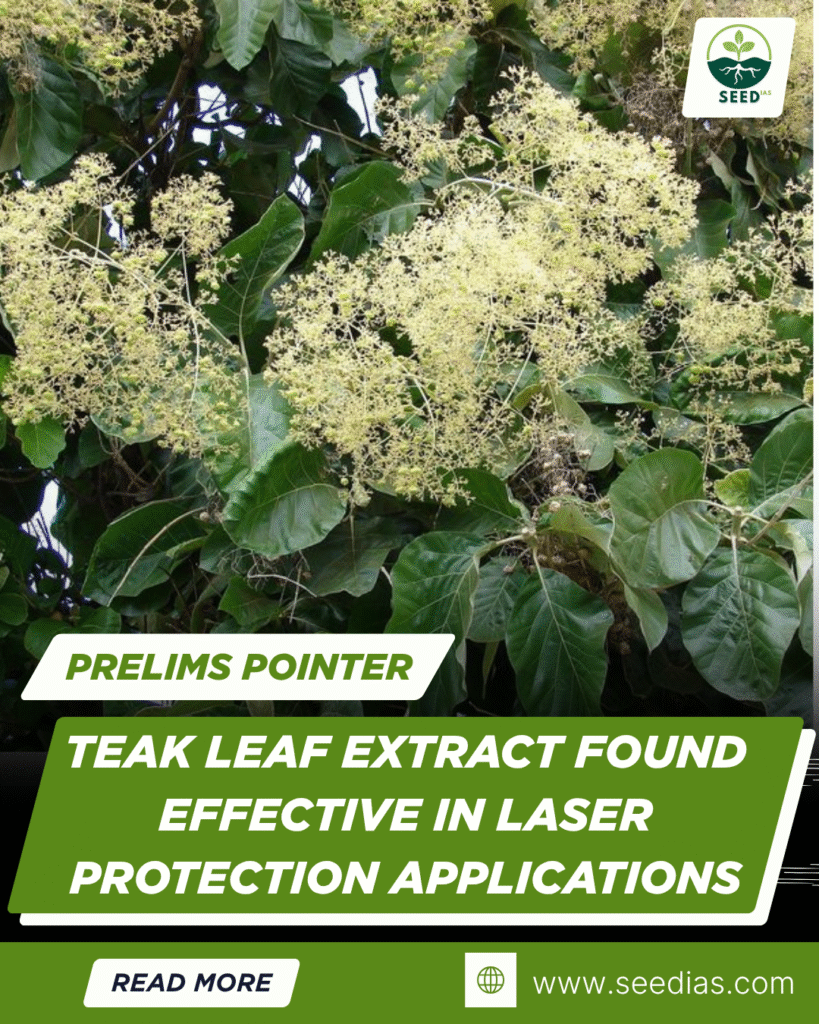Why in NEWS
Indian scientists have discovered that teak (Tectona grandis) leaf extract can serve as a natural optical limiter, protecting human eyes and optical sensors from high-intensity laser radiation using its nonlinear optical (NLO) properties.
Key Concepts and Definitions
| Term | Explanation |
|---|---|
| Optical Limiter | A device that blocks or reduces laser intensity to prevent damage. |
| Anthocyanins | Pigments found in plants that absorb light and have NLO properties. |
| Nonlinear Optics (NLO) | Branch of optics where material properties change with light intensity. |
The News in Simple Terms
- Teak leaf extract contains anthocyanins, which have light-absorbing abilities that increase with intensity.
- This makes it suitable for laser safety goggles, optical shields, and coatings to block laser beams.
- The solution offers a sustainable, cost-effective, and biodegradable alternative to synthetic optical materials.
About Teak (Tectona grandis)
| Feature | Description |
|---|---|
| Type | Large deciduous hardwood tree; known as “King of Timbers” |
| Uses | Furniture, shipbuilding, flooring, carvings, musical instruments |
| Distribution | Native to India, Myanmar, Thailand, Laos, Indonesia |
| In India | Found in MP, Maharashtra, Karnataka, Kerala, TN, Assam, and Northeast |
| Botanical Features | Large leaves, cylindrical trunk, small fragrant white flowers |
| Conservation | Green felling banned in govt forests; private plantations meet demand |
Significance of the Discovery
| Benefit | Impact |
|---|---|
| Eco-Friendly Material | Reduces reliance on synthetic, non-biodegradable optical limiters |
| Laser Safety | Can protect sensors, military optics, and human eyes from laser hazards |
| Biological Innovation | Demonstrates use of plant-based materials in advanced technology |
| Boosts Value of Teak | Adds scientific and economic value to an already valuable timber species |
In a Nutshell
Memory Code: TEAK – Teak, Eco-safe, Anthocyanin, Kinetic optics
- T – Teak leaf source
- E – Eco-friendly optical application
- A – Anthocyanin pigment with NLO properties
- K – Kinetic light filtering based on intensity
Prelims Practice Questions
- Teak leaf extract shows potential use in which of the following fields?
A. Artificial Photosynthesis
B. Optical Limiting for Laser Safety
C. Carbon Capture
D. Hydrogen Fuel Storage - Anthocyanins found in teak are known for:
A. Photosynthesis
B. Antibacterial resistance
C. Nonlinear optical properties
D. High water retention - Which of the following statements about teak is correct?
A. Teak is a coniferous evergreen tree
B. It grows well in arid and saline soils
C. It is native to South and Southeast Asia
D. Its green felling is permitted under the Forest Conservation Act, 1980
Prelims Answers with Explanations
| Qn | Answer | Explanation |
|---|---|---|
| 1 | B | Teak leaf extract, due to its nonlinear optical (NLO) properties, can limit laser intensity and is useful for laser safety applications. |
| 2 | C | Anthocyanins are natural pigments with nonlinear optical properties, enabling them to absorb high-intensity light. |
| 3 | C | Teak is a moist deciduous tree native to South and Southeast Asia, including India, Myanmar, and Thailand. |
















